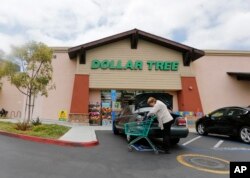U.S. stocks extended their post-U.S. election rally Tuesday with moderate gains that pushed the Dow above 19,000 for the first time and the three major indexes to record closing levels for a second straight day.
The S&P 500 ended above 2,200, led by gains in telecommunications, up 2.1 percent, and consumer discretionaries, up 1.2 percent. The small-cap Russell 2000 index also set another record-high close.
Stocks have mostly rallied since the November 8 election. Investors see President-elect Donald Trump's promises of tax cuts, higher spending on infrastructure and less regulation as beneficial to certain industries, including banking, industrials and health care.
Rally may still have legs
Robert Pavlik, chief market strategist at Boston Private Wealth in New York, said big gains that started in financials and industrials just after the election are spreading to other sectors, suggesting the rally may still have legs.
"You're seeing some strength across the board. That's a healthy sign and indicates to me that we're in a bull market," he said. "The market started to give up some gains last week, but that didn't increase selling pressure. It actually drew people back in.”
Besides being optimistic about potential fiscal policies of the new administration, investors may be feeling "things aren't as mixed up as people were worried about" under Trump, Pavlik said.
Trading volume is slipping, though, ahead of the U.S. Thanksgiving Day holiday Thursday.
Dow up 9.2 percent for year
The Dow Jones industrial average ended up 67.18 points, or 0.35 percent, to 19,023.87, the S&P 500 gained 4.76 points, or 0.22 percent, to 2,202.94 and the Nasdaq Composite added 17.49 points, or 0.33 percent, to 5,386.35.
All three indexes also hit record intraday highs. The Dow took 121 trading days to reach 18,000 from 17,000, but has since crawled along, taking another 483 days to breach 19,000.
The Dow is now up 9.2 percent for the year so far, while the S&P 500 is up 7.8 percent. But some market participants question if the rally is sustainable, with the S&P 500 trading near 17.3 times forward 12-month earnings, above the 10-year median of 14.7 times, according to StarMine data.
Dollar Tree is biggest gainer
Dollar Tree, up 8.2 percent at $88.68, was the biggest percentage gainer among discretionaries. The dollar-store chain reported a better-then-expected quarterly profit.
The health care index, which had a sharp run higher following the election, was off 1.4 percent, leading the decliners.
Medtronic tumbled 8.7 percent to $73.60 after the medical device maker reported quarterly revenue that missed expectations and cut its full-year adjusted earnings forecast.
After the bell, shares of Urban Outfitters were down 8.2 percent after the retailer reported sales that missed analysts' expectations.
Trading of shares down
About 7.3 billion shares changed hands on U.S. exchanges, compared with the 8.1 billion daily average for the past 20 trading days, according to Thomson Reuters data.
Advancing issues outnumbered declining ones on the NYSE by a 2.36-to-1 ratio; on Nasdaq, a 1.64-to-1 ratio favored advancers.
The S&P 500 posted 52 new 52-week highs and six new lows; the Nasdaq Composite recorded 319 new highs and 22 new lows.











